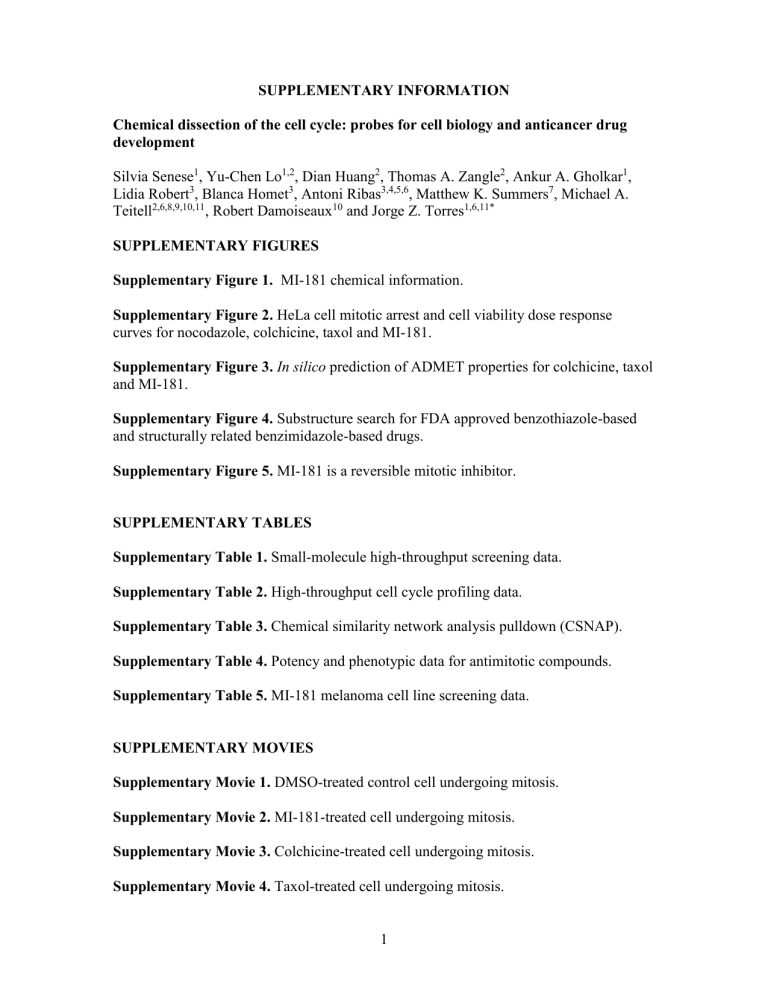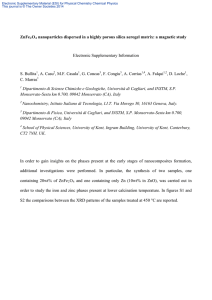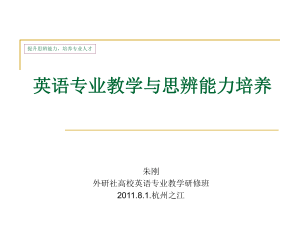supplementary Information Chemical dissection of the cell cycle

SUPPLEMENTARY INFORMATION
Chemical dissection of the cell cycle: probes for cell biology and anticancer drug development
Silvia Senese
1
, Yu-Chen Lo
1,2
, Dian Huang
2
, Thomas A. Zangle
2
, Ankur A. Gholkar
1
,
Lidia Robert 3 , Blanca Homet 3 , Antoni Ribas 3,4,5,6 , Matthew K. Summers 7 , Michael A.
Teitell
2,6,8,9,10,11
, Robert Damoiseaux
10
and Jorge Z. Torres
1,6,11*
SUPPLEMENTARY FIGURES
Supplementary Figure 1. MI-181 chemical information.
Supplementary Figure 2. HeLa cell mitotic arrest and cell viability dose response curves for nocodazole, colchicine, taxol and MI-181.
Supplementary Figure 3. In silico prediction of ADMET properties for colchicine, taxol and MI-181.
Supplementary Figure 4. Substructure search for FDA approved benzothiazole-based and structurally related benzimidazole-based drugs.
Supplementary Figure 5. MI-181 is a reversible mitotic inhibitor.
SUPPLEMENTARY TABLES
Supplementary Table 1. Small-molecule high-throughput screening data.
Supplementary Table 2. High-throughput cell cycle profiling data.
Supplementary Table 3. Chemical similarity network analysis pulldown (CSNAP).
Supplementary Table 4. Potency and phenotypic data for antimitotic compounds.
Supplementary Table 5. MI-181 melanoma cell line screening data.
SUPPLEMENTARY MOVIES
Supplementary Movie 1. DMSO-treated control cell undergoing mitosis.
Supplementary Movie 2. MI-181-treated cell undergoing mitosis.
Supplementary Movie 3. Colchicine-treated cell undergoing mitosis.
Supplementary Movie 4. Taxol-treated cell undergoing mitosis.
1
SUPPLEMENTARY FIGURES
Supplementary Figure 1. MI-181 chemical information.
2
Colchicine
Cell viability Mitotic arrest
IC
50
=0.013 μM Colchicine IC
50
=0.024
μM
Nocodazole IC
50
=0.045 μM Nocodazole IC
50
=0.129 μM
MI-181 IC
50
=0.017 μM MI-181 IC
50
=0.023 μM
Taxol
IC
50
=0.027 μM Taxol IC
50
=0.037 μM
Supplementary Figure 2. HeLa cell mitotic arrest and cell viability dose response curves for nocodazole, colchicine, taxol and MI-181.
3
ADMET properties in-silico prediction Ideal
BBB permeability (Clark and Lobell et al.) yes
Taxol no logP
H-bond donors
Polar surface area (PSA)
Molecular weight oral bioavailability (Veber Rules)
Rotatable bonds
Polar surface area (PSA)
~4
<7
4.34
4
40 –90 A 189.9
~400 yes
<10
<140 absorption/permeability (Lipinski Rules) yes
853.9 no
15
189.9 no
H-bond donors
Molecular weight logP
<5
<500
<5
4
853.9
4.34
H-bond acceptors solubility (logS)
Pgp efflux
H-bond donors
Molecular weight
<10 15
> -5.7 -8.43 no
<8
<400 yes
4
853.9
*logP: lipopholicity
*Lipinski rules (HD<5, MW<500, logP<5,
HA<10)
*Veber rules (RotB<=10, PSA<=140A)
MI-181 Colchicine no no
4.49
0
2.2
1
25.78
266.4 yes
2
83
399.4 yes
6
25.78 yes
0
266.4
4.49
2
-3.84 no
0
266.4
83 yes
1
399.4
2.2
6
-4.18 yes
1
399.4
Supplementary Figure 3. In silico prediction of ADMET properties for colchicine, taxol and MI-181.
4
Supplementary Figure 4. Substructure search for FDA approved benzothiazole-based and structurally related benzimidazole-based drugs.
5
Supplementary Figure 5. MI-181 is a reversible mitotic inhibitor.
HeLa cells were treated with the indicated drugs for 18 hours. Cells were then washed and released into the cell cycle. Protein samples were prepared at the indicated time points and were analyzed by immunoblotting with anit-p-H3 and anti-
-Tubulin antibodies.
6
SUPPLEMENTARY TABLES
Category Parameter
Assay
Library
Screen
Type of assay
Target
Primary measurement
Key reagents
Assay protocol
Additional comments
Library size
Library composition
Source
Additional comments
Format
Concentration(s) tested
Plate controls
Reagent/ compound dispensing system
Detection instrument and software
Assay validation/QC
Correction factors
Normalization
Additional comments
Post-HTS analysis Hit criteria
Hit rate
Additional assay(s)
Confirmation of hit purity and structure
Description
Cell-based
Cell cycle modulators
Cell cycle profile, detection of G1, S, G2, and G2/M arrest
Vybrant DyeCycle Green Stain (Invitrogen) p-H3-488 Antibody (Cell Signaling)
See Online Methods
79,827 compounds
Drug-like molecules
UCLA Molecular Screening Shared Resource
384-well plates
10
M, <1% DMSO
Internal controls DMSO, Taxol
Biomek FX (Beckman Coulter) and Multidrop 384
(Thermo LabSystems) liquid handlers
Acumen eX3 (TTP Labtech)
Z’ score 0.51
0.09
To internal controls DMSO and Taxol
G1-phase inhibitors (>4 STDs from the mean), Sphase inhibitors (> 5 STDs from the mean), G2/M inhibitors (>67% G2/M arrest)
Total 0.613% cell cycle modulator hit rate = 0.613%;
0.086% G1-phase inhibitors, 0.185% S-phase inhibitors, 0.009% G2-phase inhibitors and 0.333%
M-phase inhibitors
G2/M deconvolution screen for p-H3-488 antibody positives cells, CellTiter-Glo luminescent cell viability assay and immunofluorescence microscopy-based multiparametric phenotypic analyses.
Compounds were repurchased from MolPort and compound structure and purity were verified analytically
Additional comments
Supplementary Table 1. Small-molecule high-throughput screening data. Summary of screening assays, chemical library, screening conditions and post-HTS analysis.
7
Supplementary Table 2. High-throughput cell cycle profiling data.
Excel file with G1, S, G2 and M-phase inhibitor compound name and percent arrest.
Standard deviations from the mean for each phase are indicted.
Supplementary Table 3. Chemical similarity network analysis pulldown (CSNAP).
Excel file with CSNAP analysis of the top G1, S, and G2-phase inhibitors.
Supplementary Table 4. Potency and phenotypic data for antimitotic compounds.
Excel file listing M-phase inhibitors by compound name, mitotic arrest IC
50
, cell viability
IC
50
, and mitotic phenotype classification.
Supplementary Table 5. MI-181 melanoma cell line screening data.
Excel file listing cell viability IC
50
for MI-181 across a panel of melanoma cell lines.
8
SUPPLEMENTARY MOVIES
Supplementary Movie 1. DMSO-treated control cell undergoing mitosis.
Live cell time-lapse microscopy of control DMSO-treated cells.
HeLa-FUCCI cells were arrested with Thymidine for 18 hours, washed, released into fresh media and DMSO was added 6 hours post release. Images from 3 channels (phase contrast, FITC and Cy3) were captured every 15 minutes at 20X magnification with a Leica DMI6000 microscope and processed using Leica deconvolution software (Leica Microsystems) and converted to an
AVI movie. Each frame represents a fifteen-minute interval.
Supplementary Movie 2. MI-181-treated cell undergoing mitosis.
HeLa-FUCCI cells were synchronized, treated with MI-181, and imaged by live timelapse microscopy as described for Supplementary Movie 1.
Supplementary Movie 3. Colchicine-treated cell undergoing mitosis.
HeLa-FUCCI cells were synchronized, treated with colchicine, and imaged by live timelapse microscopy as described for Supplementary Movie 1.
Supplementary Movie 4. Taxol-treated cell undergoing mitosis.
HeLa-FUCCI cells were synchronized, treated with taxol, and imaged by live time-lapse microscopy as described for Supplementary Movie 1.
9









